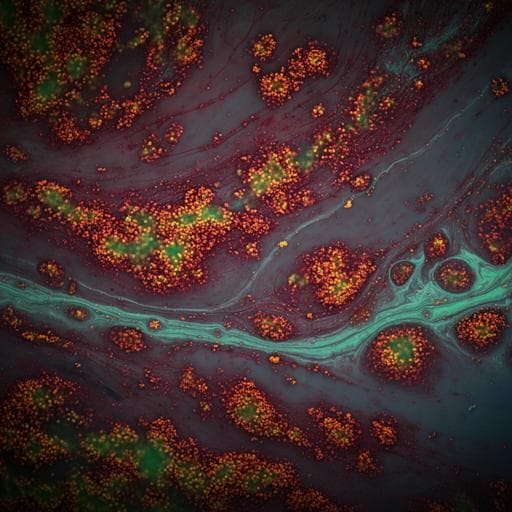
Environmental Studies and Forestry
Seasonality impels the antibiotic resistance in Kelani River of the emerging economy of Sri Lanka
M. Kumar, G. G. T. Chaminda, et al.
This fascinating study conducted by Manish Kumar, G. G. Tushara Chaminda, and Ryo Honda explores the seasonal fluctuations of antibiotic-resistant bacteria and genes in Sri Lanka's Kelani River, unveiling the impact of environmental conditions on antibiotic resistance. Dive into the details of how old antibiotics still hold sway over resistant bacteria!
~3 min • Beginner • English
Introduction
Antimicrobial resistance in the environment poses a growing public health threat, with rivers acting as key conduits for the transport and dissemination of antibiotic-resistant bacteria (ARB) and antibiotic resistance genes (ARG). Urban rivers in emerging economies often receive inputs from wastewater treatment plant (WWTP) effluents, hospitals, agriculture, aquaculture, and runoff, influencing ARB/ARG loads. Although links between antibiotics, nutrients, metals, and ARG/ARB have been documented, the role of seasonality—particularly in monsoon-dominated tropical settings—remains insufficiently characterized. The authors hypothesized that seasonality significantly influences antibiotic resistance dynamics in tropical rivers. The study’s objectives were: (i) to quantify seasonal variations in the prevalence of E. coli ARB and ARG between wet (October 2017) and dry (March 2018) seasons in Sri Lanka’s Kelani River, and (ii) to elucidate relationships among in situ water quality parameters, metals, E. coli prevalence, and antibiotic resistance using multivariate statistical analyses.
Literature Review
Prior studies indicate that WWTPs and anthropogenic activities are hotspots and sources of ARGs and ARB, with rivers facilitating rapid transport compared to lakes, which have longer retention. Elevated ARGs have been reported downstream of sewage discharges and in urban lakes and rivers (e.g., Swiss lakes, Yangtze-adjacent lakes, Chinese urban lakes, and several Indian rivers). Urban rivers impacted by treated/untreated wastewater can harbor resistant pathogens (e.g., vancomycin-resistant Klebsiella pneumoniae, Acinetobacter, Enterococci, Pseudomonas spp., Shigella spp.). Land use, WWTP capacity, and proximity to point sources influence ARG abundance (e.g., sul and tet). Heavy metals, antibiotics, and emerging contaminants (PPCPs, microplastics) correlate with ARG/ARB in tropical waters. Despite these insights, detailed assessments of seasonal variability in ARB/ARG in monsoon-driven tropical rivers are limited, motivating the present study.
Methodology
Study area: The Kelani River (144 km) in Sri Lanka flows through Colombo to the west coast, draining ~2230 km² and receiving ~2400 mm annual rainfall. The lower basin is urbanized with industrial zones (Export Processing Zones, EPZ), while the upper basin is vegetated. The river is a primary drinking water source for Colombo but is heavily polluted.
Sampling design: Four river locations were selected based on in situ profiling (pH, temperature, EC, DO, ORP, bicarbonate). Sampling captured two seasons: wet (October 2017; K11–K14) and dry (March 2018; K22–K24). Due to similarity among upstream samples in October, only three sites were analyzed in March 2018.
Metals and in situ parameters: Water was collected in 125 mL polyethylene bottles, filtered (0.45 µm), preserved with concentrated HNO3, and analyzed for As, Cd, Co, Cr, Cu, Mn, Ni, Pb, and Zn by ICP-MS (PerkinElmer NexION 2000). In situ pH, temperature, EC, DO, and ORP were measured with a multiprobe (Hanna 981A); bicarbonate via titration. Arsenic was below detection in all samples.
E. coli isolation and enumeration: Samples were serially diluted in phosphate-buffered 0.8–0.85% NaCl. Chromocult Coliform Agar ES (Merck) plates were prepared; 4 mL of diluted sample plus 36 mL buffer were filtered via 37 mm monitor kits (Advance Toyo). After 22–24 h incubation at 35.5 °C, E. coli colonies (dark blue/violet) and other coliforms (pink-red) were counted to obtain CFU mL−1.
Antibiotic susceptibility testing (Kirby–Bauer): Twenty morphologically similar E. coli colonies per sample were cultured in PERLCORE Tryptic-Soy Broth at 35 ± 2 °C to McFarland 0.5 (~1.5×10^8 CFU mL−1). PERLCORE Sensitivity Test Agar plates were inoculated and KB antibiotic discs placed ≥24 mm apart. Incubation was 16–18 h at 35–37 °C. Zones of inhibition were measured. Antibiotics tested: fluoroquinolones (norfloxacin, ciprofloxacin, levofloxacin) and non-fluoroquinolones (kanamycin monosulfate, tetracycline, sulfamethoxazole).
ARG screening and quantification: From each site, 2 L were filtered (50–800 mL depending on turbidity); filters were preserved in 2x DNA/RNA Shield (ZymoResearch). DNA was extracted (FastDNA Spin Kit, MP Biomedicals). PCR was performed (Bio-Rad 2720; 30 cycles) targeting genes by mechanism: (1) DNA gyrase inhibition: aac-(6')-Ib-cr, gyrA, parC, qnrB, qnrs (fluoroquinolones); (2) folate synthesis inhibition: tetW (tetracyclines), dfr1 (trimethoprim); (3) cell wall synthesis inhibition: blaCTX, blaSHV, blaTEM, ampC (β-lactams). qRT-PCR (Stratagene MX3000P; Takara PrimeScript RT Master Mix) quantified qnrs, sul1, blaCTX, and 16S rRNA; runs included duplicates and blanks; primer conditions optimized and dissociation curves generated.
Quality assurance and statistics: Multiple blanks were included for culture media, monitor kits, and buffers. Data were normalized (z-scores). PCA with orthogonal varimax rotation and hierarchical cluster analysis (Ward’s method) were conducted in SPSS v21. PCA results were visualized in 3D; dendrograms summarized clustering.
Key Findings
- E. coli prevalence: Across sites, E. coli ranged from 10 to 27 CFU mL−1. The maximum in October (wet season) was 27 CFU mL−1, about three times higher than the March (dry season) maximum (9 CFU mL−1). Total coliforms showed similar ranges between seasons (October: 23–31 CFU mL−1; March: 17–26 CFU mL−1), with higher E. coli at the Seethawaka EPZ upstream site, suggesting industrial wastewater influence.
- Antibiotic susceptibility: Most E. coli isolates were multidrug resistant. Resistance to older antibiotics (tetracycline, sulfamethoxazole) was higher than to newer fluoroquinolones. Example composite values (Table 1): CIP-resistant fraction ~47% (Oct) vs 40% (Mar); NFX 35% (Oct) vs 10% (Mar); KM 16% (Oct) vs 0% (Mar); ST 70% (Oct) vs 60% (Mar); TC 70% (Oct) vs 60% (Mar). Fluoroquinolone resistance (LVX, CIP, NFX) decreased longitudinally from upstream (K1) to downstream (K4), consistent with self-purification/degradation. Seasonal effects were evident: fluoroquinolone susceptibility decreased in summer at most locations, while non-fluoroquinolone resistance (KM, ST, TC) tended to be higher downstream, reflecting usage patterns.
- ARG detection and seasonality: Genes conferring resistance to tetracyclines (tet) and sulfonamides (sul1) were detected in all samples, aligning with phenotypic resistance to ST and TC. blaCTX1 and qnrs were higher in March (dry season) than October (wet), indicating seasonal influence and possible concentration effects under lower flows; ampC was detected in 2017 but not in 2018. Overall, ARG copy numbers were higher in March 2018 than October 2017.
- Metals and water quality: Arsenic was below detection. Seasonal shifts in EC and some metals (e.g., higher EC and varied Mn, Ni, Cr, Cu) suggested that ionic enrichment during the dry season may enhance ARG occurrence.
- Multivariate analyses: Four principal components explained 84.74% of variance. PC1 (26.84%): pH, temperature, EC, ARGs (blaCTX1, qnrs), ARB (LVX). PC2 (21.47%): Mn, sul1, ORP, E. coli. PC3 (19.08%): Zn, NFX, KM, TC. PC4 (17.35%): Pb, Cd. Cluster analysis showed four clusters in October 2017 reducing to three in March 2018, indicating fewer governing factors and tighter coupling among variables in the dry season.
- Conceptual synthesis: Dry season associated with increased ARG copies, higher EC/ORP, reduced number of governing components, decreased fluoroquinolone resistance, and increased resistance to some non-fluoroquinolones, reflecting combined effects of hydrology, contaminant inputs, and usage patterns.
Discussion
Findings support the hypothesis that seasonality significantly modulates antibiotic resistance in a tropical, monsoon-influenced river. Higher E. coli counts and widespread multidrug resistance indicate persistent fecal and antibiotic pressures. The strong resistance to older antibiotics (TC, ST) likely reflects historical and ongoing use (including agriculture) and persistence of associated ARGs (sul1, tet). Seasonal increases in ARG copies during the dry season (March) suggest concentration effects due to reduced dilution, elevated EC/ionic strength, and potential co-selection from metals. In contrast, fluoroquinolone resistance exhibited notable seasonal variability and spatial decline downstream, potentially due to self-purification, dilution, and degradation. PCA and clustering demonstrate that the set of variables governing ARB/ARG dynamics becomes simpler and more cohesive in the dry season, while wet-season dynamics appear more heterogeneous and driven by multiple sources (e.g., runoff, combined sewer overflows). Comparisons to other urban rivers (e.g., Chaophraya) highlight differing dominant drivers (land-use vs climatic/seasonal factors) and underscore the need to consider local hydrology and infrastructure (WWTPs, DWTPs). Overall, ARB/ARG prevalence is shaped by both source inputs and environmental conditions (seasonality, discharge, redox, metals, EC).
Conclusion
This study demonstrates that seasonality markedly influences antibiotic resistance in the Kelani River. E. coli isolates frequently exhibited multidrug resistance, with the highest resistance to older antibiotics (tetracycline and sulfamethoxazole). ARGs (sul1, tet, blaCTX1, qnrs) were prevalent, with higher copy numbers in the dry season (March 2018) than the wet season (October 2017). Multivariate analyses revealed shifts in governing factors and reduced complexity in the dry season, implicating hydrological and geochemical conditions (e.g., EC enrichment) in ARG/ARB dynamics. These insights emphasize that management of antibiotic resistance in urban tropical rivers must account for seasonal hydrology, contaminant inputs, and co-selective pressures. Future work should expand spatial and temporal coverage, include sediment monitoring, quantify antibiotic concentrations, and evaluate treatment interventions (e.g., tertiary treatment, effective disinfection, sludge management). Identifying critical hotspots and tracking seasonal changes can inform targeted mitigation strategies in emerging economies.
Limitations
- Sampling design covered two campaigns (wet: October 2017; dry: March 2018) with only three sites analyzed in March 2018, limiting temporal and spatial resolution.
- Limited number of sampling points upstream and downstream; authors note need for additional locations, especially before Seethawaka WWTP and in urban downstream reaches.
- ARG panel, while representative, is not exhaustive; some genes showed NA entries due to not analyzed.
- Water-column focus without concurrent sediment sampling may underrepresent environmental reservoirs of ARG/ARB.
- Observational design limits causal attribution among metals, antibiotics, and resistance patterns; antibiotic concentrations were not measured.
- Potential variability in colony selection (20 colonies per sample) may influence phenotypic resistance proportions.
Related Publications
Explore these studies to deepen your understanding of the subject.







